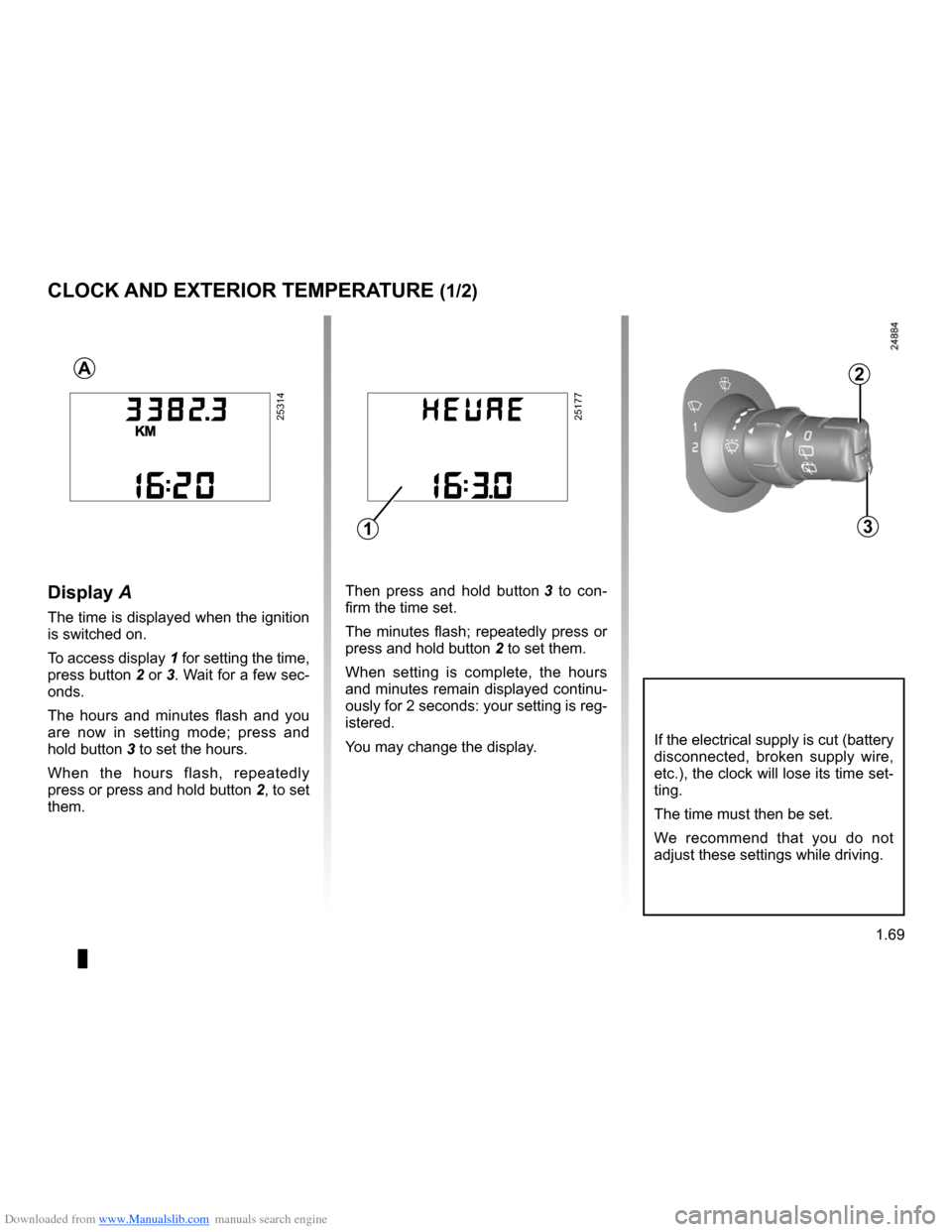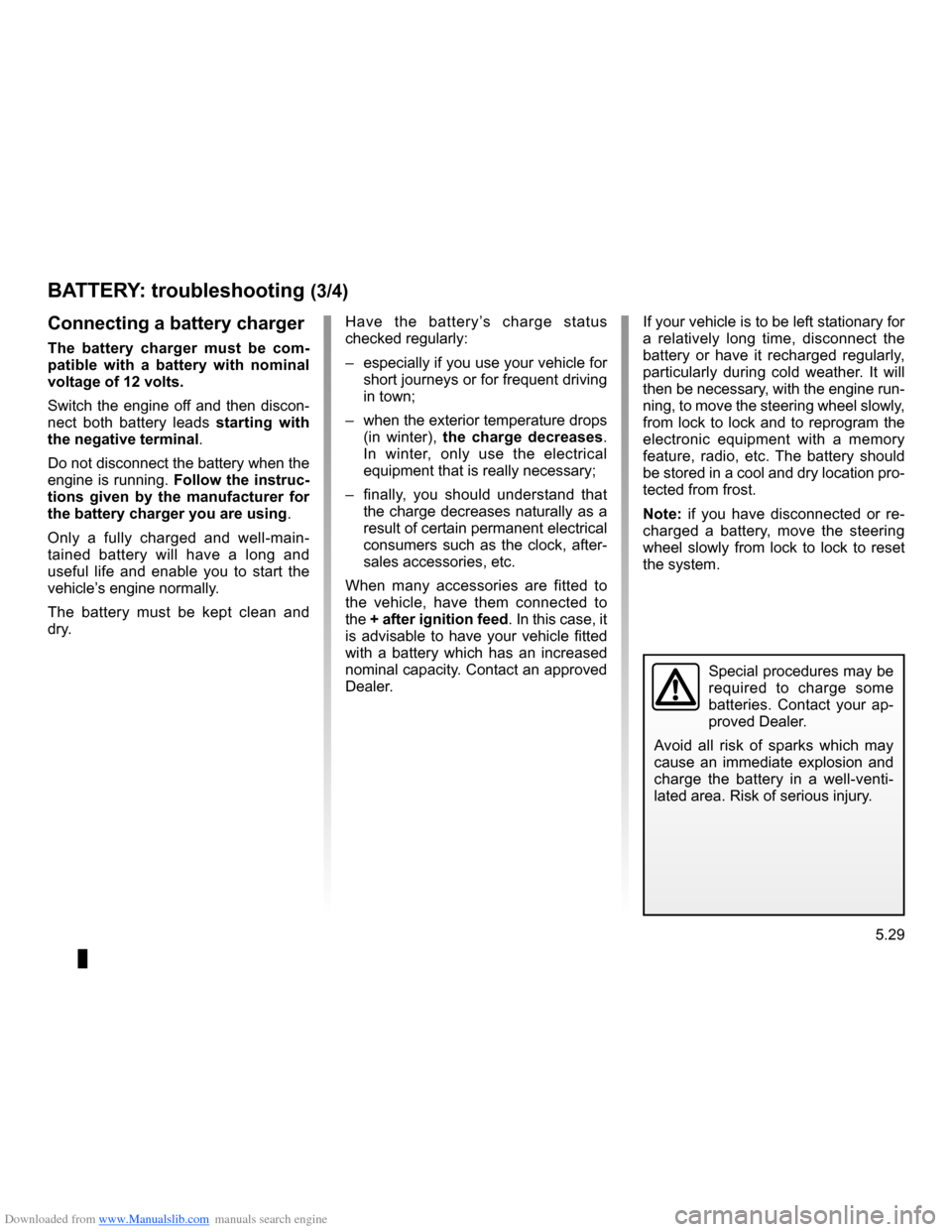set clock RENAULT CLIO 2009 X85 / 3.G Owners Manual
[x] Cancel search | Manufacturer: RENAULT, Model Year: 2009, Model line: CLIO, Model: RENAULT CLIO 2009 X85 / 3.GPages: 264, PDF Size: 15.68 MB
Page 75 of 264

Downloaded from www.Manualslib.com manuals search engine
clock .....................................................(up to the end of the DU)clock .....................................................(up to the end of the DU)control instruments ...............................(up to the end of the DU)
1.69
ENG_UD10538_1Heure (X85 - B85 - C85 - S85 - K85 - Renault)ENG_NU_853-3_BCSK85_Renault_1
Clock and exterior temperature
If the electrical supply is cut (battery disconnected, broken supply wire, etc.), the clock will lose its time set- ting.
The time must then be set.
We recommend that you do not adjust these settings while driving.
251772531425314
Then press and hold button 3 to con- firm the time set.
The minutes flash; repeatedly press or
press and hold button 2 to set them.
When setting is complete, the hours and minutes remain displayed continu- ously for 2 seconds: your setting is reg- istered.
You may change the display.
Display A
The time is displayed when the ignition is switched on.
To access display
1 for setting the time,
press button 2 or 3. Wait for a few sec- onds.
The hours and minutes flash and you are now in setting mode; press and
hold button 3 to set the hours.
When the hours flash, repeatedly
press or press and hold button 2, to set them.
CLOCK AND EXTERIOR TEMPERATURE (1/2)
A2
31
Page 76 of 264

Downloaded from www.Manualslib.com manuals search engine
external temperature .............................................(current page)
1.70
ENG_UD10538_1Heure (X85 - B85 - C85 - S85 - K85 - Renault)ENG_NU_853-3_BCSK85_Renault_1
Vehicles fitted with navigation aid systems, telephones, etc.
Refer to the separate instructions for the function to understand the special features of this equipment.
External temperature
indicator
Special note:
When the outside temperature is –3°C to +3°C, the °C characters flash (signal- ling a risk of ice on the road).
If the electrical supply is cut (battery disconnected, broken supply wire, etc.), the clock will lose its time set- ting.
The time must then be set.
We recommend that you do not adjust these settings while driving.
External temperature in- dicator
As ice formation is related to climatic exposure, local air humidity and temperature, the external temperature alone is not sufficient to detect ice.
Display B
The display B shows:
– the radio;
– the time;
– the exterior temperature.
The time and/or external tempera- ture are displayed when the ignition is switched on.
Resetting the clock
Press button:
H for the hours, M for the minutes.
CLOCK AND EXTERIOR TEMPERATURE (2/2)
B
H
M
Page 217 of 264

Downloaded from www.Manualslib.com manuals search engine
JauneNoirNoir texte
5.29
ENG_UD12592_2Batterie : dépannage (X85 - B85 - C85 - S85 - K85 - Renault)ENG_NU_853-3_BCSK85_Renault_5
BATTERY: troubleshooting (3/4)
Special procedures may be required to charge some batteries. Contact your ap- proved Dealer.
Avoid all risk of sparks which may cause an immediate explosion and charge the battery in a well-venti- lated area. Risk of serious injury.
If your vehicle is to be left stationary for a relatively long time, disconnect the battery or have it recharged regularly, particularly during cold weather. It will then be necessary, with the engine run- ning, to move the steering wheel slowly, from lock to lock and to reprogram the electronic equipment with a memory feature, radio, etc. The battery should be stored in a cool and dry location pro- tected from frost.
Note: if you have disconnected or re- charged a battery, move the steering wheel slowly from lock to lock to reset the system.
Have the battery’s charge status checked regularly:
– especially if you use your vehicle for
short journeys or for frequent driving in town;
– when the exterior temperature drops
(in winter), the charge decreases. In winter, only use the electrical equipment that is really necessary;
– finally, you should understand that
the charge decreases naturally as a result of certain permanent electrical consumers such as the clock, after- sales accessories, etc.
When many accessories are fitted to the vehicle, have them connected to the + after ignition feed. In this case, it is advisable to have your vehicle fitted with a battery which has an increased nominal capacity. Contact an approved Dealer.
Connecting a battery charger
The battery charger must be com- patible with a battery with nominal voltage of 12 volts.
Switch the engine off and then discon- nect both battery leads starting with the negative terminal.
Do not disconnect the battery when the engine is running. Follow the instruc- tions given by the manufacturer for the battery charger you are using.
Only a fully charged and well-main- tained battery will have a long and useful life and enable you to start the vehicle’s engine normally.
The battery must be kept clean and dry.
Page 257 of 264

Downloaded from www.Manualslib.com manuals search engine
7.1
FRA_UD14717_4Index (X85 - B85 - C85 - S85 - K85 - Renault)ENG_NU_853-3_BCSK85_Renault_7
changing a bulb .....................................................5.15 → 5.24changing a wheel...............................................................5.11changing gear ........................................................2.31 → 2.38child restraint/seat .................................................1.35 → 1.46child safety...... 1.2 – 1.3, 1.11, 1.13 – 1.14, 1.31, 1.35 → 1.46,
2.5, 3.17 → 3.19
child seats..............................................................1.35 → 1.45children .............. 1.2 – 1.3, 1.7, 1.11, 1.13 – 1.14, 3.17 → 3.20cigar lighter ........................................................................\
3.28clock .......................................................................1.69 – 1.70closing the doors ...................................................1.13 → 1.18control instruments ................................................1.52 → 1.70controls ..................................................................1.48 → 1.51courtesy light ............................................................ 3.23, 5.23courtesy mirrors .................................................................3.22cruise control .........................................................2.27 → 2.30cruise control-speed limiter....................................2.24 → 2.30
Ddashboard..............................................................1.48 → 1.51deadlocking the doors ................................................ 1.6, 1.12demistingrear screen ............................................................ 3.4, 3.13windscreen ............................................................ 3.5, 3.14dimensions .................................................................6.4 – 6.5dipstick........................................................................\
.........4.4doors/tailgate ...........................................................1.2 → 1.18driver’s position .....................................................1.48 → 1.55driving .................... 2.2, 2.4 → 2.11, 2.13 → 2.15, 2.17 → 2.40driving positionsettings ............................................................1.24 → 1.27
Eelectric windows ....................................................3.17 → 3.19Electronic Stability Program: ESP ..........................2.19 – 2.20emergency brake assist.....................................................2.23
AABS ........................................................................\
2.17 – 2.18accessories........................................................................\
5.34accessories socket ................................................... 3.26, 3.28additional methods of restraint ..........................................1.34side protection .............................................................1.33to the front seat belts .......................................1.28 → 1.31to the rear seat belts ....................................................1.32adjusting your driving position ...................... 1.20 → 1.27, 3.29advice on antipollution ...........................................2.13 → 2.15air bag....................................................................1.28 → 1.34activating the front passenger air bags ........................1.47deactivating the front passenger air bags ....................1.46air conditioning ........................................................3.4 → 3.16air vents ......................................................................3.2 – 3.3anti-corrosion check ..............................................6.15 → 6.20anti-corrosion protection .........................................4.12 – 4.13anti-lock braking system: ABS ................................2.17 – 2.18antipollutionadvice ..............................................................2.13 → 2.15ashtray ........................................................................\
.......3.28audible and visual signals..................................................1.74automatic gearbox (use) ........................................2.31 → 2.33automatic gearbox selector lever...........................2.31 → 2.33
Bbattery........................................................... 4.11, 5.27 → 5.30battery (remote control) .....................................................5.31bonnet........................................................................\
..........4.2brake fluid ........................................................................\
....4.8bulbschanging ..........................................................5.15 → 5.24
Ccatalytic converter................................................................2.9central door locking .................... 1.6, 1.9 → 1.12, 1.15 → 1.18
AlphABEtiCAl inDEx (1/5)